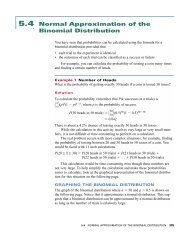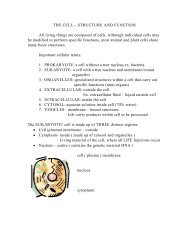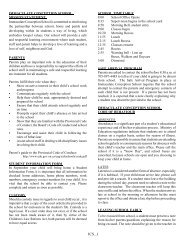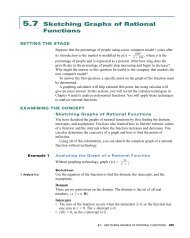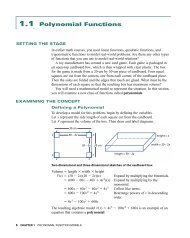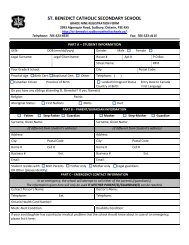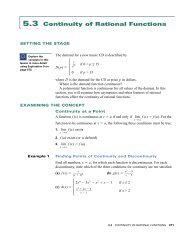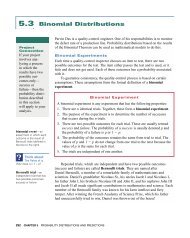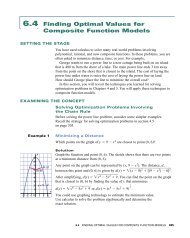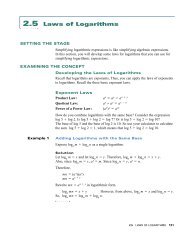5.4 Rate of Change of a Rational FunctionâThe Quotient Rule
5.4 Rate of Change of a Rational FunctionâThe Quotient Rule
5.4 Rate of Change of a Rational FunctionâThe Quotient Rule
You also want an ePaper? Increase the reach of your titles
YUMPU automatically turns print PDFs into web optimized ePapers that Google loves.
3<br />
2<br />
1<br />
s(t)<br />
s(t) =<br />
5t<br />
t 2 + 1<br />
0 2 4 6 8 10<br />
Solution<br />
When the object changes direction, its velocity, s′(t), changes sign.<br />
The velocity function is v(t) s′(t).<br />
s′(t) <br />
<br />
or<br />
s′(t) 0 when t ±1. But t ≥ 0, so the negative root is inadmissible.<br />
The velocity changes sign when t 1. The object changes direction after<br />
exactly one second.<br />
The acceleration function is a(t) v′(t) s′′(t).<br />
s′′(t) <br />
<br />
<br />
<br />
<br />
<br />
(5)(t 2 1) (2t)(5t)<br />
<br />
( t 2 1 ) 2<br />
5 5t 2<br />
<br />
t 4 2t 2 1<br />
10t(t 4 2t 2 1) (4t 3 4t)(5 5t 2 )<br />
<br />
(t 4 2t 2 1) 2<br />
10t 5 20t 3 10t (20t 3 20t 5 20t 20t 3 )<br />
<br />
[(t 2 1) 2 ] 2<br />
10t 5 20t 3 30t<br />
<br />
(t 2 1) 4<br />
10t(t 4 2t 2 3)<br />
<br />
(t 2 1) 4<br />
10t(t 2 3)(t 2 1)<br />
<br />
(t 2 1) 4<br />
10t(t 2 3)<br />
(t 2 1) 3<br />
1 3)<br />
5(1 t)(1 t)<br />
<br />
t 4 2t 2 1<br />
Simplify.<br />
Factor.<br />
Simplify.<br />
Therefore, s′′(1) 10( ,<br />
( 2)<br />
3<br />
or 2.5.<br />
The object’s acceleration at the instant it changes direction is 2.5 units/s 2 .<br />
t<br />
Graph the position function. When t 1, the object has stopped<br />
briefly. Before t 1, the object was moving away from a point. After<br />
t 1, the object is moving toward the point. Velocity is represented<br />
by the slopes <strong>of</strong> tangent lines to this graph. At the maximum point on<br />
the graph, the slope <strong>of</strong> the tangent line is 0. The velocity is decreasing<br />
before t 1. And the velocity is decreasing after t 1. The graph is<br />
concave down at its peak. The acceleration is negative.<br />
Example 4<br />
Analyzing the Pollution Problem<br />
Recall the original problem in Setting the Stage:<br />
Polluted water flows at a rate <strong>of</strong> 3 m 3 /min into a pond. The pond initially<br />
holds 10 000 m 3 <strong>of</strong> unpolluted water. The initial concentration <strong>of</strong> pollutant in<br />
the polluted water is 9 kg/m 3 . The concentration <strong>of</strong> pollutant, c, in the pond at<br />
27t<br />
t minutes is modelled by c(t) 10 00<br />
.<br />
0 3t<br />
(a) What is the domain <strong>of</strong> this function?<br />
(b) At what rate is the concentration changing after one hour? one day?<br />
one week?<br />
<strong>5.4</strong> RATE OF CHANGE OF A RATIONAL FUNCTION—THE QUOTIENT RULE 381



